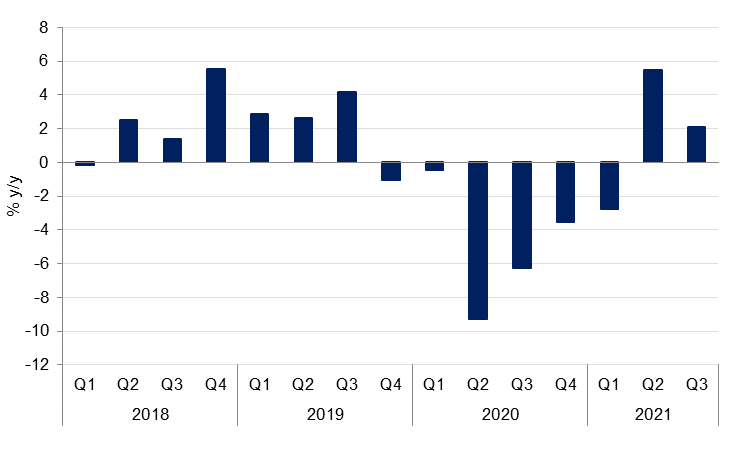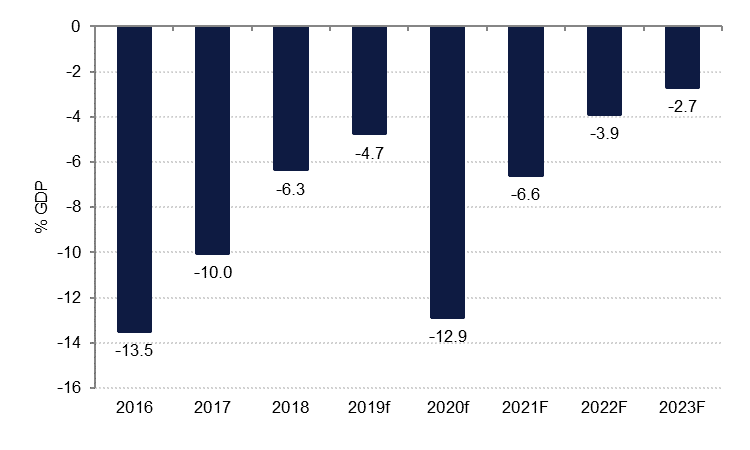
Bahrain’s economy grew 2.1% y/y in Q3 21, after recording rates of -2.8% y/y and 5.5% y/y in Q1 21 and Q2 21 respectively according to figures by the Ministry of Finance and National Economy. Growth during Q3 21 was led by the non-oil economy which expanded at 2.4% y/y in Q3 21. The oil sector contracted -4.1% y/y in Q3 21. We forecast 2021 GDP growth at 3.4% following a contraction of -5.8% in 2020.
 Source: Haver Analytics, Emirates NBD Research
Source: Haver Analytics, Emirates NBD Research
Bahrain’s COVID-19 dynamics may weigh on growth in Q1 2022 as the Omicron variant has caused case numbers to almost triple since early January. The kingdom recorded almost 3000 cases in the last week of January from almost a 1000 in early January and a low of 40 in December. However we expect growth to accelerate to 4.1% in 2022 as both oil and non-oil sectors rebound from the pandemic.
The budget deficit likely narrowed to around -6.6% of GDP in 2021 from -12.9% in 2020. We expect the deficit to narrow further this year to -3.9% of GDP as Bahrain continues to implement fiscal reforms, including a doubling of the VAT rate to 10% (effective 1 January 2022), streamlining subsidies and reducing expenditure. The government is now aiming to achieve its zero-deficit target by 2024, two years later than originally planned.
 Source: Haver Analytics, Emirates NBD Research
Source: Haver Analytics, Emirates NBD Research
Net foreign reserves at the central bank rose to USD4.27bn in November 2021, more than double the level at the end of 2020. Import cover has improved to three months.
In November the government of Bahrain announced new details about its USD 30bn post-pandemic Economic Recovery Plan. The plan is designed to drive growth, boost employment for citizens and attract USD 2.5bn in foreign direct investment by 2023, and increase VAT from 5% to 10%, as the seeks kingdom balance its budget by 2024. The plan aims to create more than 20,000 jobs for Bahrain’s citizens annually until 2024, and train 10,000 more through its Tamkeen education program for the private sector. It comprises 22 projects across important sectors, including telecoms, tourism, education, manufacturing, and health. Key projects include the creation of five communities on newly constructed islands, eventually raising Bahrain’s total land area by more than 60%. Another key project is new 25-kilometre, four-lane King Hamad Causeway that aims to increase cross-border trade and travel with Saudi Arabia and the wider GCC.
As part of the Government of Bahrain’s Economic Recovery Plan, the government launched the Industrial Sector Strategy (2022-2026), on Dec 30 2021. The plan aims to raise the contribution of the industrial sector’s to GDP, to 14.5% in 2026 from 12.8% in 2019. And increase the employment of Bahrainis in the sector to 25.3% of the total and with a target of employing 65K by 2026. The targeted industries as part of the strategy, include the downstream industries such as aluminum and petrochemicals, renewables energy including blue and green hydrogen, sectors that will also contribute to the Kingdom’s commitment to reach net zero carbon emissions by 2060. Other sectors include food, pharmaceuticals, and micro-electronics
Earlier this January the government also launched the 2022-2026 Telecommunications, Information Technology and Digital Economy Strategy as part Economic Recovery Plan. The strategy will focus on enhancing the digital policies and legal framework elements that are critic to developing the country’s digital infrastructure, in addition to ensuring comprehensive fiber-optics coverage across residential and commercial areas in Bahrain. The government earlier announced almost 1300 services will be available through online government portals including the issuance of visas, marriage certificates, identity documents for newborns and post-construction services.